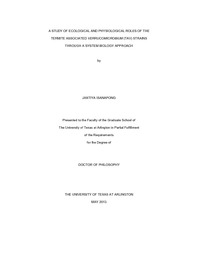
ATTENTION: The works hosted here are being migrated to a new repository that will consolidate resources, improve discoverability, and better show UTA's research impact on the global community. We will update authors as the migration progresses. Please see MavMatrix for more information.
Show simple item record
| dc.contributor.author | Isanapong, Jantiya | en_US |
| dc.date.accessioned | 2013-07-22T20:15:11Z | |
| dc.date.available | 2013-07-22T20:15:11Z | |
| dc.date.issued | 2013-07-22 | |
| dc.date.submitted | January 2013 | en_US |
| dc.identifier.other | DISS-12106 | en_US |
| dc.identifier.uri | http://hdl.handle.net/10106/11877 | |
| dc.description.abstract | Termite hindguts are populated by a dense and diverse community of microbial symbionts working in concert to transform lignocellulosic plant material and derived residues into acetate, to recycle and fix nitrogen, and to remove oxygen. Although much has been learned about the breadth of microbial diversity in the hindgut, the ecophysiological roles of its members is less understood. In this study, we present new information about the ecophysiology of microorganism Diplosphaera colotermitum strain TAV2, an autochthonous member of the Reticulitermes flavipes gut community. An integrated high-throughput approach was used to determine the transcriptomic and proteomic profiles of cells grown under hypoxia (2% O₂) or atmospheric (20% O₂) concentrations of oxygen. Our results revealed that genes and proteins associated with energy production and utilization, carbohydrate transport and metabolism, nitrogen fixation, and replication and recombination were up-regulated under 2% O₂. The metabolic map developed for TAV2 indicates that this microorganism may be involved in biological nitrogen fixation, amino acid production, hemicellulose degradation, and consumption of O₂ in the termite hindgut. Variation of O₂ concentration explained 55.9% of the variance in proteomic profiles, suggesting an adaptive evolution of TAV2 to the hypoxic periphery of the hindgut. Our findings advance the current understanding of microaerophilic microorganisms in the termite gut and expand our understanding of the ecological roles for members of the phylum Verrucomicrobia. Moreover, one of the enzymes in xylanolytic system involved in hydrolyzing acetyl group from hemicellulose xylan, acetyl xylan esterase (AXE), was found to be up-regulated from both transcriptomic and proteomic analyses, so the axe gene has been cloned and expressed into E. coli BL 21(DE3), and then the AXE enzyme was purified. From the enzyme activity assays, the enzyme shows activity toward acetylated xylan by releasing acetyl group from the xylan backbone. The optimum temperature and pH of the enzyme was at 50°C and pH 7.0, respectively. The ability of the AXE in deacetylating xylan suggests the roles of AXE in open up the xylose backbone for other enzymes like xylanase, xylosidase, and cellulase to access and degrade hemicellulose and cellulose. | en_US |
| dc.description.sponsorship | Rodrigues, Jorge | en_US |
| dc.language.iso | en | en_US |
| dc.publisher | Environmental & Earth Science | en_US |
| dc.title | A Study Of Ecological And Physiological Roles Of The Termite Associated Verrucomicrobium (TAV) Strains Through A System Biology Approach | en_US |
| dc.type | Ph.D. | en_US |
| dc.contributor.committeeChair | Rodrigues, Jorge | en_US |
| dc.degree.department | Environmental & Earth Science | en_US |
| dc.degree.discipline | Environmental & Earth Science | en_US |
| dc.degree.grantor | University of Texas at Arlington | en_US |
| dc.degree.level | doctoral | en_US |
| dc.degree.name | Ph.D. | en_US |
Files in this item
- Name:
- Isanapong_uta_2502D_12106.pdf
- Size:
- 2.818Mb
- Format:
- PDF
This item appears in the following Collection(s)
Show simple item record


